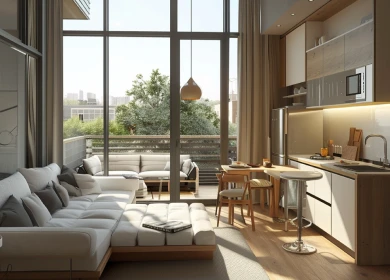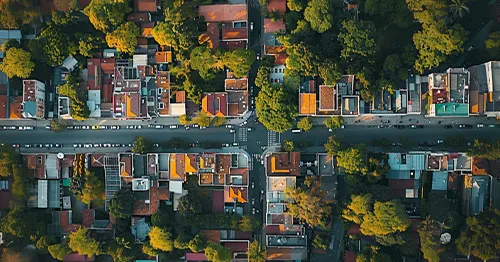Updated: 12 Jul, 2024
Did you hear? Your suburb may be on a list of high risk postcodes as identified by one of the Australia’s biggest banks!
National Australia Bank (NAB) has identified 40 suburbs where “significant deterioration in credit risk has been observed” and a further 43 suburbs in which it expects heightened risk in the near future.
Making up the majority of high risk suburbs, New South Wales consisted entirely of Sydney suburbs, 34 in total!
This postcode policy update will still allow you to buy properties in these locations but the amount you can borrow (Loan to Value Ratio) has been capped and you’ll now need a much bigger deposit to qualify.
Which suburbs are currently a high risk?
NAB would previously lend up to 95% of the property value for any location in Australia but things have changed. These are the suburbs that affect home loans.
The suburbs identified as presenting a credit risk (Group A) are mostly mining towns in Western Australia and Queensland, a likely symptom of the downturn in the energy, mineral and manufacturing sectors.
For the following suburbs, NAB has capped the Loan to Value Ratio or LVR to 70% of the value of the property. In other words, you’ll need a minimum of 30% of the property value (plus the costs of completing the purchase) as a deposit:
Western Australia
6390 Bannister, Boddington, Crossman
6429 Boorabbin, Bullabulling, Coolgardie
6436 Menzies, Ularring
6437 Leinster, Sir Samuel
6438 Leonora, Lake Darlot
6440 Bandya, Beadell, Cosmo, Newbery
6442 Kambalda East, Kambalda West
6642 Angelo River, Capricorn, Karalundi
6646 Wiluna, Lake Carnegie, Little Sandy Desert
6710 Cane, Onslow, Peedamulla, Talandji, Yannarie
6713 Dampier Archipelago, Dampier
6714 Atonymyre, Balla Balla, Baynton
6716 Pannawonica, Fortescue, Hamersley Range, Millstream
6718 Roebourne, Whim Creek
6720 Cossack, Point Samson, Wickham
6721 Indee, Mundabullangana, Pardoo
6722 Boodarie, De Grey, Finucane, Pippingarra, South Hedland
6751 Chichester, Innawanga, Juna Downs
6753 Newman
6754 Paradburdoo
6758 Nullagine
6760 Marble Bar
Queensland
4210 Guanaba, Maudsland, Oxenford
4211 Advancetown, Beechmont, Binna Burra
4680 Gladstone
4717 Blackwater
4720 Emerald, Yamala
4740 Mackay Region
4743 Suttor, Glenden
4744 Moranbah
4745 Dysart
4746 May Downs, Middlemount
4805 Bogie, Bowen, Gumlu
Northern Territory
0885 Alyangula
South Australia
Olympic Dam, Roxby Downs, Roxby Downs Station
Tasmania
7155 Kettering
7467 Queenstown, Lake Margaret
7468 Strahan, Macquarie Heads
7469 Zeehan, Trial Harbour, Renison Bell
7470 Rosebery
Which suburbs are expected to be a high risk in the future?
As mentioned previously, properties showing characteristics of being a high risk postcode (Group B) was dominated by Sydney suburbs, from the central business district (CBD) and inner city areas, to select suburbs further west.
Apart from Sydney, five Melbourne suburbs, as well as the CBDs of Adelaide, Perth and Brisbane all caught the eye of NAB.
For these postcodes, the bank has capped the LVR to 80% of the property value. In other words, you’ll need a minimum of 20% of the property value (plus the costs of completing the purchase) as a deposit:
New South Wales
2000 Sydney
2205 Arncliffe, Turrella, Wolli Creek
2113 East Ryde, Macquarie Park, North Ryde
2769 The Ponds
2209 Beverly Hills, Narwee
2019 Banksmeadow, Botany
2199 Yagoona
2017 Waterloo, Zetland
2067 Chatswood, Chatswood West
2211 Padstow, Padstow Heights
2008 Chippendale, Darlington
2141 Berala, Lidcombe, Rookwood
2153 Baulkham Hills, Bella Vista, Winston Hills
2210 Lugarno, Peakhurst, Peakhurst Heights, Riverwood
2118 Carlingford
2222 Penshurst
2166 Cabramatta, Cabramatta West, Canley Vale/Heights, Lansvale
2767 Bungarribee, Doonside, Woodcroft
2127 Newington, Sydney Olympic Park, Wentworth Point
2144 Auburn
2566 Varroville, Bow Bowing, Minto, Raby, St Andrews
2140 Homebush, Homebush West
2194 Campsie
2037 Forest Lodge, Glebe
2768 Glenwood, Parklea, Stanhope Gardens
2142 Camellia, Clyde, Granville, Holroyd, Rosehill, South Granville
2150 Harris Park, Parramatta
2220 Hurstville, Hurstville Grove
2168 Ashcroft, Busby, Cartwright, Green Valley
2151 North Rocks, North Parramatta
2146 Toongabbie, Old Toongabbie
2195 Lakemba, Wiley Park
2112 Denistone East, Putney, Ryde
2208 Kingsgrove
Victoria
3000 Melbourne CBD
3004 St Kilda Road Central
3006 South Bank, South Wharf
3008 Docklands
3067 Abbotsford
South Australia
5000 Adelaide CBD
5001 Adelaide CBD
Western Australia
6000 Perth CBD
Queensland
4000 Brisbane CBD
What does this mean for first home buyers?
High risk postcodes in themselves aren’t a new thing. Many lenders currently limit the amount they will lend in remote areas or small country towns, and if you want a pretty accurate idea of this, check out the postcode calculator.
What the real shocker with the policy change is that NAB has classified large parts of Sydney as a high risk.
Previously, for inner city suburbs, you would be liable to pay Lender Mortgage Insurance (LMI) when borrowing more than 70% for an inner city property (postcode 2000). With this change, LMI may in fact still apply above 70% but your overall borrowing cap will be 80% regardless.
Since these changes have already come into affect, Home Loan Experts managing director Otto Dargan said first home buyers are likely to be hardest hit.
“Some first home buyers that are going to auctions will be in for a nasty shock,” he said.
“They rarely get told by the banks which areas they aren’t able to buy in so they may find their approval withdrawn after they win an auction.”
You can still borrow at 90-95% and here's how
Yes, you can still borrow up to 95% of the property value for any postcode in Australia!
How?
These policy changes are from NAB and lending policies are different for every bank and lender in Australia!
We have around 40 lenders on our panel to choose from and a team of highly experienced mortgage brokers who are in a position to find a lender that will accept your property and its location.
Complete our free assessment form and one of our brokers will contact you to discuss your situation and where you’re looking to purchase a property.
Why has NAB made this decision?
These new LVR caps on select postcodes follows the introduction of stricter investment lending requirements by a number of major banks, including NAB.
A NAB spokesperson said that they recognise that “no two suburbs are the same” and the update to its lending policy “takes into account a range of economic factors”.
“As a responsible lender, we continually monitor the performance of local markets and review our practices to ensure that our lending is responsible and sustainable,” the spokesperson said.
What this basically means is that NAB are mainly concerned with spreading their risk:
- The bank’s risk weighting: NAB likely saw a concentration risk in having a lot of their home loan book focused on specific areas. They want to “spread their risk” by making it tougher to qualify for a home loan in these postcodes.
- The likelihood of default: Based on the local economy and employment conditions in in the area, certain suburbs have an inherently higher risk of defaults. This is particularly true of the WA, QLD and SA locations listed. Again, spreading the risk is the likely strategy here.
- Properties being overvalued: Cities and suburbs that have seen exponential growth in a short amount of time like Sydney and parts of Melbourne are likely overvalued and if the market were to correct itself, as wHeregroup’s Todd Hunter and our own Hank Hong recently suggested, it could see these properties fall below the value of the mortgage.
Will other banks follow NAB’s lead?
It’s hard to say at the moment. Certainly, many banks are making it tougher for investors to get a loan so LVR caps on postcodes may be the next logical step.
What may happen is that banks may charge some kind of risk premium for borrowers wanting to purchase in particular suburbs or banks may make it tougher to qualify for an interest only loan.
Of course, further tightening of lending policies really depends on how the Australian property market travels in the next few months.
Can’t wait that long?
If you’re looking to buy a property in one of NAB bank’s high risk suburbs or you’re simply not sure whether your particular property will be accepted as security for a home loan, call us on 1300 889 743 or complete our free assessment form today.
We’re credit specialists that have a thorough knowledge of lending requirements regarding property type and location.




